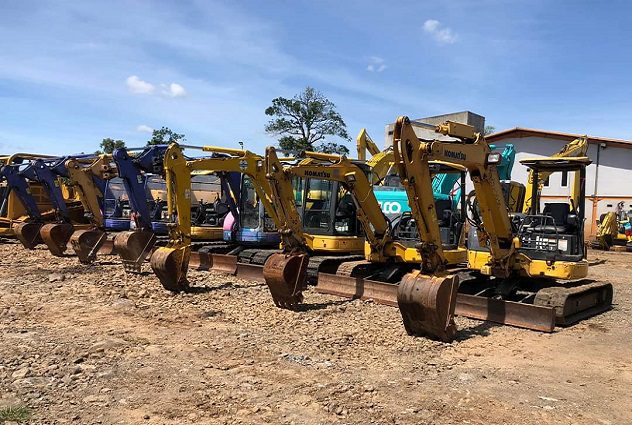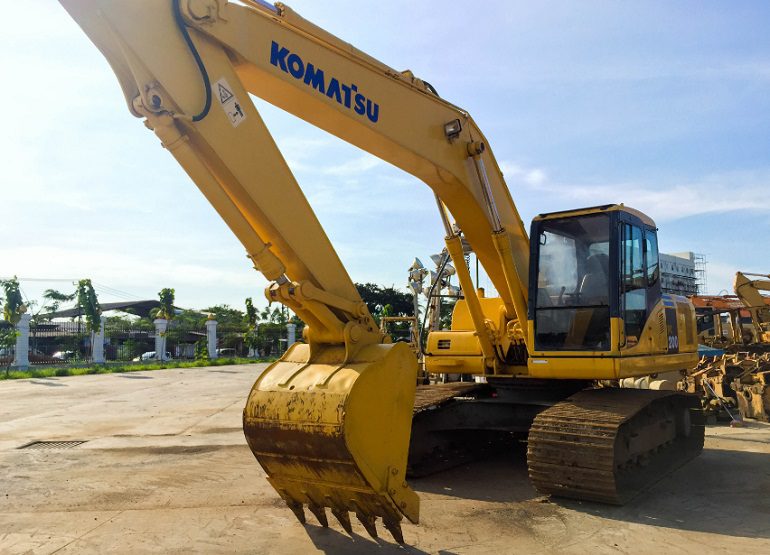Heavy equipment, especially Excavators, plays a central role in various construction and development projects. Its unique and versatile capabilities make it one of the most sought after and used heavy equipment. It is important for every operator to understand each Excavator component and its function so that the work process runs efficiently.
What is an Excavator?

An excavator is a type of heavy equipment that has a distinctive physical structure and is designed to handle various construction and excavation tasks. Known for its striking appearance and ability to withstand a variety of terrain conditions, Excavators are characterized by a long arm that is attached to the top of the vehicle. At the end of the arm there is a bucket, a large container with a tip shaped like a shovel, used for digging, transport, and moving materials, like land, pasir, or stone.
Excavators have the ability to move 360 degrees, which allows it to reach and operate its bucket in various terrain conditions in various directions. The excavator driving engine is located at the bottom, providing the stability and strength needed to handle heavy loads and intensive digging tasks.
When seen from afar, The excavator looks like a futuristic and powerful machine, and this machine is the backbone of many construction projects. Its advantage is in reaching work areas that are difficult to access, its ability to reach significant excavation depths, and its powerful carrying capacity makes it one of the most efficient and versatile machines in the modern construction industry.
8 Excavator Components

The following are several parts of the Excavator and their role in supporting various construction tasks:
- Machine
The heart of an excavator, which provides the power necessary to operate the hydraulic system, track, and other components. The engine is usually located at the rear of the excavator, and is usually a diesel engine designed to produce high torque and power output with low fuel consumption. The machine is connected to a hydraulic system, which provides the power required to operate the boom, arm, and heavy equipment bucket.
- Cabin
Enclosed operator compartment where the operator sits to control and operate the machine. Cabs are usually designed to provide a comfortable and safe working environment for the operator, with features such as air conditioning, heater, vibration damper, and sound dampening to significantly increase operator comfort and productivity. The cabin is also equipped with various controls such as a digital cluster, music system, charging support, AC, Safety Controls, dll. to enable High Performance & Operating Convenience.
- Main Control Valves (MCV)
An important component of the hydraulic system on an excavator, which controls the flow and direction of hydraulic fluid to various hydraulic aggregates such as cylinders, motor, and valves that move heavy equipment. The main control valve is located near the hydraulic pump, which puts pressure on the fluid before it enters the valve. This valve consists of several coils that direct the flow of hydraulic fluid to various hydraulic circuits, so that the operator can control the movement of the machine precisely.
- Boom
Important components of excavators, which extends out from the main body of the heavy equipment and is used to lift and move heavy objects. The boom is usually mounted on a pivot point at the base of the machine and is operated by a hydraulic cylinder that extends and retracts to control boom movement.
- ARM
Another important component of the excavator, consisting of a telescopic or fixed-length structure that extends from the boom and is used to control the machine's bucket or other attachment. The arm is usually operated by a hydraulic cylinder that controls its movement, so operators can reach and move materials precisely. Sleeve length and shape may vary, depending on the type of excavator and the intended use of the machine.
- Bucket
Essential equipment for excavators, used for digging, scooping, loading and unloading materials such as soil, debris, or rocks. Buckets come in various shapes and sizes, depending on the type of excavation work and the material being moved. The bucket is usually mounted on the excavator arm and operated by a hydraulic cylinder that controls its movement, so operators can dig and move material with precision.
- Counterweight
Heavy metal components installed at the rear of the machine to balance the weight of the machine & Providing a Safe Work Environment & Stable when working. Counterweights are usually made of cast iron or steel and can weigh several tons, depending on the size and weight of the machine. The counterweight is designed to balance the weight of the boom, arm, and excavator buckets when extended and in use, which helps maintain the stability of the machine and prevents it from tipping over.
- Undercarriage
One of the most important components, because it supports the weight of the machine and allows it to move over various types of terrain. The undercarriage consists of tracks, sprocket, idler, roller, and final drives. Each of these components plays an important role in the excavator's ability to perform its tasks efficiently and effectively.
Understanding each Excavator component and its function is very important for every operator. An efficient Excavator requires a deep understanding of how each part interacts and supports overall operations. With this understanding, operators can optimize Excavator performance, increase productivity, and maintaining security at construction sites. This also ensures that the Excavator can be used optimally in various conditions and construction tasks.
Excavator Support Heavy Equipment

Besides Excavator, There are other heavy equipment such as motor graders and wheel loaders that support the excavator work process. Excavator limitations in several aspects can be overcome with support from additional heavy equipment. Motor Grader, for example, helps level the surface of the soil, while the Wheel Loader has the function of transporting materials efficiently. The combination of these various heavy equipment creates a strong team to handle construction projects of varying complexity.
Closing
In a construction project, Excavators are not just ordinary heavy equipment; it is a complex machine with interrelated components. A thorough understanding of the function of each part and how the tool works is essential. This not only improves operational efficiency but also creates a safer and more productive work environment. With technology and design continuing to develop, Excavators remain the backbone of the modern construction industry.
PT Perkasa Sarana Utama is the right solution for sewa excavator quality, We will deliver our best heavy equipment to your project location with our competent operators. Contact us immediately to get a special offer today.








